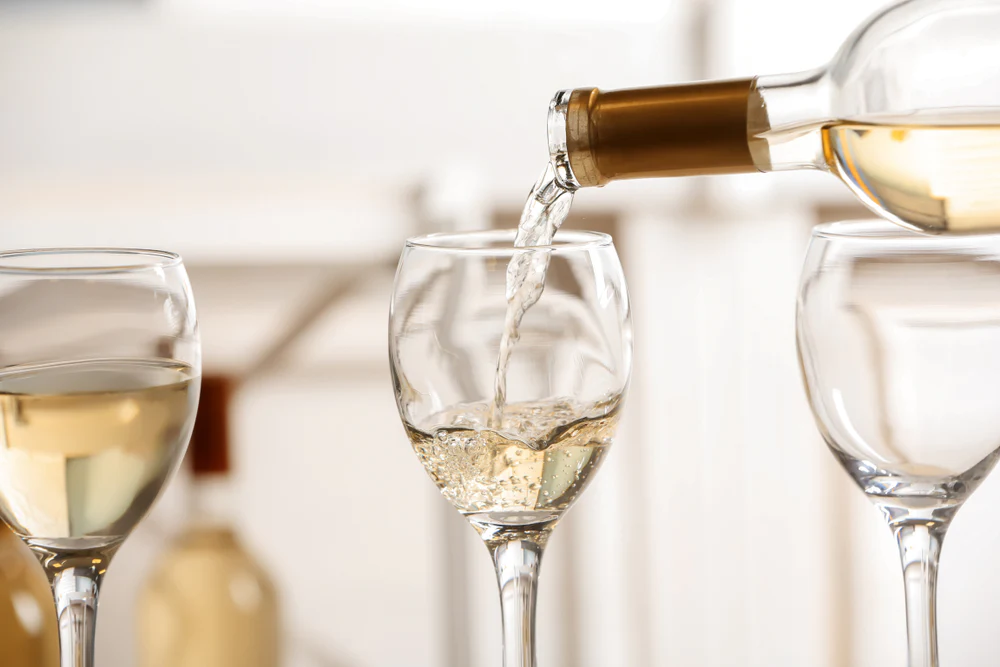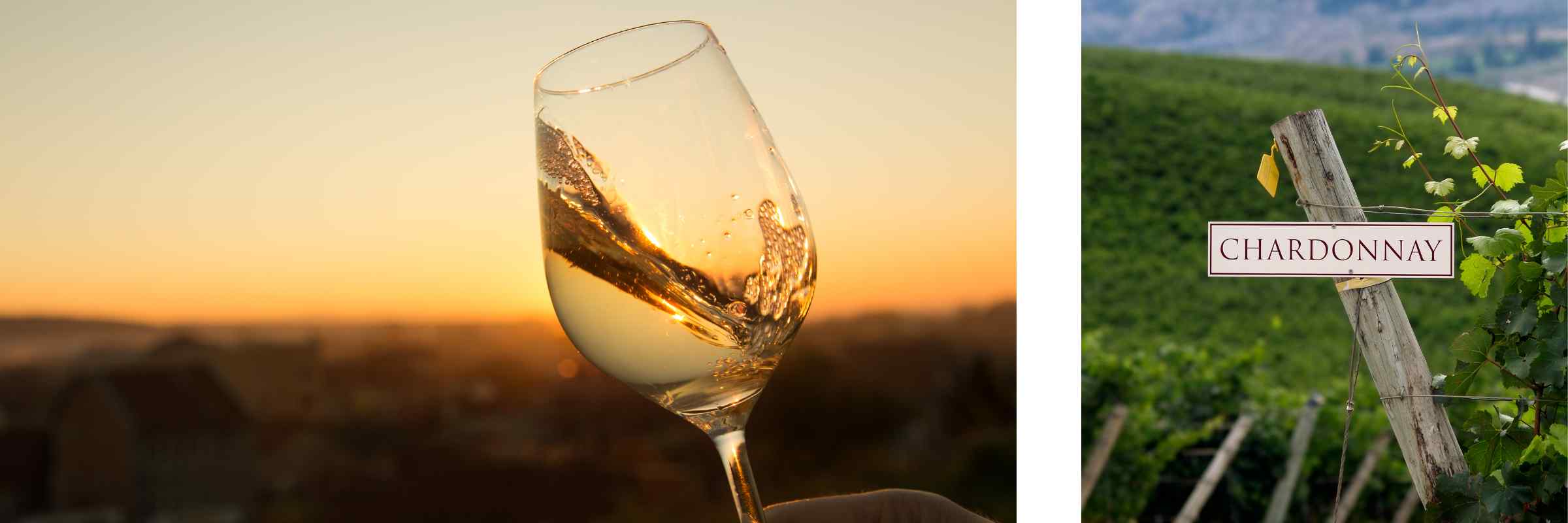Should Chardonnay be chilled? It’s a topic that has led to discussions among wine lovers for years. One of the most well-liked white wine varieties worldwide, Chardonnay is often served cold. However, others believe that drinking Chardonnay at casual temperatures may enhance its tastes and aromas as wine culture develops and the tastes become more experimental.
In this post called ”Do you drink Chardonnay cold?”, we’ll look at the age-old debate of whether Chardonnay is best served cold or warm.
1. Do you drink Chardonnay cold?
Yes, you should drink Chardonnay cold. The ideal storage temperature for Chardonnay is 55–60 °F (13–16 °C).
However, the serving temp is much lower, so make sure the wine bottle is refrigerated to 48 °F (9 degrees Celsius) so it can be served cold although the exact temperature will depend on the style of the Chardonnay bottle.
We should chill Chardonnay, but why? Each wine has a perfect serving temperature that will preserve its wonderful aromas. There is no standard temperature for serving wine.
Since room temperature is warmer than the suggested serving temperature for wines, you should typically cool all wines.

White wine should be served between 45 and 55 °F (8 and 12 °C). Red wine tastes best between 55 and 65 °F (12 and 18 °C), while dessert wines are best served between 41 to 45 °F (5-7 °C). It’s also recommended to drink and serve sparkling wine cool.
Chardonnay should never be served warm since it makes it difficult to discern between flavors, and if it is served too cold, you won’t be able to detect all of the wine’s subtle scents. Therefore, you should take additional care when presenting Chardonnay!
|
Temperature |
|
| Storage Temperature |
51 – 59°F (11 – 15°C) |
|
Served Temperature |
45 – 55°F (7 – 13°C) |
2. What is Chardonnay?

Origin
Every wine-producing nation uses Chardonnay, which is a French grape variety that originated in Burgundy. Here, there are a variety of styles, from lean, mineral-driven Chablis to opulent, oaked expressions in Meursault.
The grape grows in California in various climates, producing wines that range from being mineral-rich in the chilly Sonoma Coast to being tropical and luxurious in the warmer Napa Valley.
Australia’s colder temperate regions, such as the Yarra Valley or Margaret River, produce fruit-forward but revivingly acidic Chardonnays. Many are created in the Burgundian fashion.
Tasting notes
Depending on the region and vinification circumstances, chardonnay can be either rich and buttery or lean and acidic. Overall, it can be more complex and fruit-forward when it comes from hotter locations like Napa and lighter and sharper when it comes from colder places like Burgundy.
Apples, pears, citrus fruit, apricots, gingers, melons, papaya, and white flowery aromas are traditional Chardonnay flavors. There may also be buttery-toasty flavors when it is aged in oak, which can occasionally be mistaken for grape features.
ABV
Chardonnay has an ABV of 13.5 to 14.5%, which is considered to be quite a high level for a wine. However, as some wines have an extra-high ABV of 15%, this does not always imply that Chardonnay is the most intense wine. Chardonnay is therefore regarded as a pretty powerful wine, although not the strongest.
Food pairings
- Chicken:
Chicken and wine go together frequently. A lovely, light chicken meal pairs well with a fine glass of Chardonnay. Of course, what we’re talking about here is a perfectly grilled chicken breast with a flavorful cream sauce rather than your local fried chicken.
When serving chicken and Chardonnay, stick to white flesh; reserve the dark flesh for red wines. If you want your chicken to go well with the Chardonnay, you should also stay away from sauces that are too sweet.
- Cheese:
There are a few factors you’ll want to take into consideration when pairing Chardonnay with your choice of cheese, but you won’t go wrong with most of them.
If your Chardonnay wine is substantially oak-aged, you should go for stronger cheeses like Camembert, English hard cheddar cheese, or bleu cheese. Your best bets for pairing with unoaked Chardonnay would be brie or goat cheese.
- Seafood:
Butter or nutty tastes will complement Chardonnay beautifully. It will go well with seafood preparations based on shellfish, including crab meat, lobster meat, shrimp, and mussels. Additionally, you’ll discover that Chardonnay also goes well with halibut and other flaky white fish.
A good pan-seared fish dish would go well with a bottle of Chardonnay that has a pronounced oak flavor.
You can see more:
- Merlot vs Cabernet Sauvignon: Explore the Key Differences
- Does Chardonnay Go Bad? Expert Advice for Wine Storage
- How Is Cabernet Sauvignon Served? All You Need To Know
3. Top 3 Popular Styles of Chardonnay and Their Ideal Serving Temperature
Sparkling Chardonnay:

This is not an oaked Chardonnay that tastes like soda. In terms of manufacturing and style, it is significantly different. Its grapes are selected early to produce an incredibly refreshing wine, which is one of the main contrasts.
Sparkling Chardonnay is possibly the finest example of sparkling wine. Most quality Champagne-inspired mixes include it. The best way to enjoy sparkling Chardonnay is chilled. (43-47°F or 6-8°C)
Unoaked Chardonnay:

The name speaks for itself. During fermentation and aging, an unoaked Chardonnay doesn’t come into contact with any oak. This allows Chardonnay’s natural characteristics to show through.
Unoaked Chardonnays are fresh white wines with exquisite floral flavors and mouthwatering acidity that are best served when they come straight out of the fridge. (47-49°F or 7-9°C)
Oaked Chardonnay:

The term “oaked Chardonnay” or “oaky Chardonnay” often refers to wine that has been aged in brand-new oak barrels. Chardonnay’s potential is developed in a variety of ways by new wood barrels. They impart baked apple, sweet spice, and even smokey characteristics to Chardonnay.
Those are Chardonnay wines that are rich, full-bodied, and have a lot of opportunity to mature. It is recommended to serve these glasses of Chardonnay a little bit warmer than the unoaked ones. (50-55°F or 10-13°C)
|
Chardonnay’s style |
The best temperature to serve |
| Sparkling Chardonnay |
43-47°F (6-8°C) |
| Unoaked Chardonnay |
47-49°F (7-9°C) |
| Oaked Chardonnay |
50-55°F (10-13°C) |
4. How to serve Chardonnay at the perfect temperature?
A wine cooler is the most effective way to keep Chardonnay as well as other wines at the ideal temperature, but not everyone can afford one or has enough space. The same thing happens with a wine cellar. So, what are your other choices if you don’t have suitable wine storage?
One that is most evident is a fridge, which is a fixture in every house and works great for serving cool wine. Simply place the wine bottle in the kitchen refrigerator for 15 minutes to half an hour before drinking, based on the temperature of the refrigerator.
You may also store it in the refrigerator and let it out for sixty minutes before serving it. You may also use a thermometer to monitor the temperature of the wine bottle.
The freezer can be used as a temporary solution. The bottle should be OK after 10 minutes in the freezer. However, keep in mind to remove the bottle from the freezer since freezing might cause it to explode. At about 22 °F (-5 °C), wine begins to freeze.
Even though the wine will warm up once it is on the table, you may still enjoy a glass while the bottle remains cool to the touch.
Using an ice bucket is another simple method of cooling wine. You only need to add some ordinary salt into a bucket of cold water for a chemical reaction to take place; this will cause the temperature to drop, allowing you to chill your favorite Chardonnay bottle.
5. What glass should Chardonnay be served in?
Our answer is a white wine glass.

Your wine can be improved with the appropriate glass. The improvement of flavor, smell, and temperature are all significantly influenced by the form of the glass. Chardonnay is another example of this.
White wines require a certain glass. Chardonnay should be served in a regular glass of white wine, or better still, the largest and broadest white wine glass available.
The longer stem helps the wine keep the temperature stable for a longer period, while the cup’s form enhances the scents. Larger glasses in particular aid in oxidizing the wine, which enhances the smell.
6. How not to chill wine and how should we chill Chardonnay fast?
Your wine might be incorrectly chilled in a variety of ways. The first and most commonly wrong way is to chill your wine with ice cubes. Even while it will cool your beverage, it will also dilute the flavor and fragrance of the wine. If you must use cubes, reusable ice cubes are recommended.
Another mistake is using chilly, ice glasses. You cannot fast-cool wine using that procedure since the outer layer of the glass that is chilled is insufficient.
Contrary to these mistakes, there are a few other methods you can try at home to rapidly chill wine.
The first is using frozen grapes instead of ice cubes. Many people find it pleasant to be served with frozen grapes in their glass of Chardonnay. The second method to try is to cover your wine bottle in a moist paper towel before placing it in the freezer. Don’t forget to remove the wine from the container after a short while. Your wine shouldn’t become too chilly.
7. How to store an opened Chardonnay properly
It’s critical to follow a few instructions once you’ve cracked open a bottle of Chardonnay to maintain its freshness and stop it from going bad. For storing opened Chardonnay, try these quick tips:
-
Seal the bottle with its cork:
After pouring the Chardonnay, be careful to securely reseal the bottle using the cork that came with it or a wine stopper. This will lessen the likelihood of oxygen getting inside the bottle and damaging the wine.
-
Use a wine preserver:
Use a wine preserver: Buying a wine preserver might be a smart move if you regularly find yourself with partly-drunk bottles of Chardonnay. Wine preservers keep wine fresher longer by taking the oxygen out of the bottle. Vacuum pumps and inert gas sprays are only two examples of the many types of wine preservers that are available.
-
Put the bottle in the fridge:
Contrary to red wines, Chardonnay is better off being kept in the fridge after opening. The wine’s tastes and aromas are preserved for a longer amount of time because of the slower oxidation caused by the colder temperature.
Editor’s notes: Chardonnay may normally be savored for up to three to five days after opening when stored correctly in the refrigerator. It’s crucial to remember that after the first one or two days, the flavor and freshness of the wine may start to deteriorate. Try to finish the opened Chardonnay as quickly as possible to ensure the highest quality.
8. FAQs
Q: What is the proper way to sip Chardonnay?
Chardonnay is best served cold, like other white wines. When wine is served too warm, the flavors blur and the alcohol seems heated. The tastes and fragrances are diminished when it is too cold. The ideal temperature range is between 50 and 55°F, which may be reached after two hours in the fridge or 30 to 40 minutes in an ice bath.
Q: Why is Chardonnay superior?
The major flavor character would vary depending on whether the wines were made in wood or stainless steel and how long they aged during the second fermentation. These flavors get creamier and nuttier as the wine matures.
Q: Does Chardonnay require air to breathe?
Aeration of white wines can enhance their smoothness, harmony of flavors, and ability to express their genuine personalities. We’ve discovered that white wines like Chenin, Burgundy, and even Chardonnay benefit from aeration.
Q: Is Chardonnay usually dry or sweet?
Most typically a dry white wine, chardonnay. Even while it includes fruity aromas that could provide the impression of sweetness, it typically lacks any remaining sugar. But sweeter varieties of Chardonnay are also possible. The most popular sparkling wine for this is Champagne.
Q: How long does Chardonnay last in the refrigerator?
White wines with a lot of body, like Viognier, Muscat, and oaked Chardonnay, keep well for three to five days in the fridge when corked. When corked, sparkling wines last for one to three days in the fridge before losing their carbonation.
Q: Can Chardonnay be frozen?
Yes. The wine will only frost below its freezing point, it’s vital to remember that. You can have a wine slushy at or above, of course. Check the alcohol per volume (ABV) of your wine as well as the temperature inside your freezer, which the FDA states should be 0 degrees Fahrenheit.
Q: How should Chardonnay be stored?
White wine should be stored at a temperature of between 45 and 65 °F (7 – 18 °C). To keep your wine cold, put it in a cellar, inside closet, or wine refrigerator. White wine should be kept in a dark location away from fluorescent and direct sunlight since it is extremely sensitive to light.
Q: How come Chardonnay has a sour taste?
It’s also preferable to stay away from acidic meals unless your Chardonnay is particularly acidic, such an unoaked cool climate Chardonnay. Your Chardonnay may taste sour if it contains too much acid, like that found in caper, olive, raw tomato, or tangy vinaigrettes. The same is true for bitter vegetables.
9. Conclusion
Finally, whether you enjoy Chardonnay cool or at a normal temperature ultimately depends on personal choice. Although wine is often served chilled, some say that a little warming up can improve the wine’s tastes and aromas.
It’s crucial to remember that drinking Chardonnay too warm might cause it to lose some of its delicate features. The decision is ultimately up to you, but we hope that our article Do you drink Chardonnay cold? can help you in making a reasonable one.

With over a decade of experience in viticulture, Simon Conner is the perfect writer to help you find and maintain your prized vintages. As an expert on food, wine, and kitchen products, he offers his expertise to guide clients through every step involved with collecting and selling wines.

